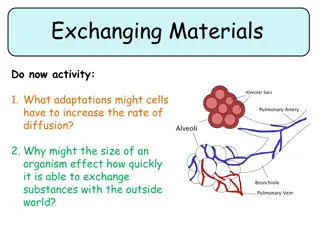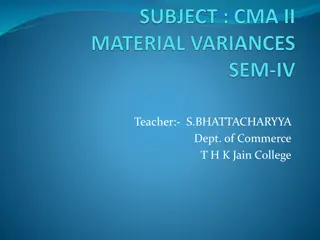
Educational Disparities Due to Material Deprivation
Explore the impact of poverty and material factors on educational outcomes, societal disparities, and the long-term effects of deprivation. Learn about studies, statistics, and hidden costs affecting educational attainment, offering insight into the importance of addressing deprivation's effects early on.
Uploaded on | 4 Views
Download Presentation

Please find below an Image/Link to download the presentation.
The content on the website is provided AS IS for your information and personal use only. It may not be sold, licensed, or shared on other websites without obtaining consent from the author. If you encounter any issues during the download, it is possible that the publisher has removed the file from their server.
You are allowed to download the files provided on this website for personal or commercial use, subject to the condition that they are used lawfully. All files are the property of their respective owners.
The content on the website is provided AS IS for your information and personal use only. It may not be sold, licensed, or shared on other websites without obtaining consent from the author.
E N D
Presentation Transcript
Can poverty alone explain educational failure? TO WHAT EXTENT DO MATERIAL FACTORS EXPLAIN DIFFERENT ATTAINMENT LEVELS BETWEEN SOCIAL GROUPS?
Poor diet Difficult working conditions Low pay work Poor health Low Poverty qualifications Criminality Prejudice and discrimination Fewer useful contacts Fewer opportunities
What are the issues? Children who grow up in poverty have the lowest levels of educational attainment. The gap between the poor and the remainder of the population is growing as the children grow older. Fewer from the working class go on to further and higher education. Sociologists explain this by referring to material deprivation.
Facts about deprivation According to government statistics, The UK has one of the worst records in Europe for high levels of child poverty. In 2007, 2.9 million British children were poor In 2004, one in four British children were poor 10.2 per cent of children in the UK (1.3 million) are classified as being in severe poverty. There is a strong association between parents low level of educational attainment and severe child poverty.
Discussion point Why is it important to understand the effects of deprivation?
Halsey, Heath and Ridge (1980s) Published the famous longitudinal study Origins and Destinations. Poverty was identified as a critical factor in school failure.
Smith and Noble (1995), There are a number of additional hidden costs that are part of maintaining a child's education, school uniform, school dinners, travelling to school, necessary equipment, educational trips with the school
Fernstein (2003) The educational achievement of a 26 year old could be accurately predicted by the wealth of the household when the child was 22 months. Gaps were already opening up in attainment levels between children of different social background before they had all of their first teeth.
Hutchings (2003) If students from low-income families went to university, they often had to get evening jobs in order to pay for their course. This may then possibly have the effect of them obtaining a lower degree or even having to leave the course before completing it.
Kingdon and Cassen (2007) Factors associated with poverty such as free school meals, low levels of family employment, single parent families and poor educational qualifications of parents all contributed to low achievement. Disadvantaged children also attend schools that rate low in the league tables.
Government policy: EMA In 2002, the British government announced that it was providing a grant of 30 per week from September 2004 onwards to help some 16-19 year old students to stay in education. This scheme had already been piloted in some parts of the country and evidence showed a 6% increase in those who had stayed on in education. (DfES 2002) Unfortunately, these grants were small, and therefore there was insufficient assistance available for all those who wished to continue their education.
Good family Few children Good health Comfortable home Good education Influential friends Pleasant work Staying rich and comfortable
Assessment Questions to consider: Outline and explain the impact of material deprivation on educational success. Discuss reasons for the underachievement of working class children in education. Identify and explain reasons why children from poorer families tend to do less well in schools than those from wealthier backgrounds.
Essay Plan Outline and evaluate factors outside of school which affect attainment (35) Intro Sociologists are interested in whether factors inside or outside of school are largely responsible to educational attainment. Should they tackle teachers or poverty? Factors outside of school identified are cultural (Functionalist) or material deprivation (Marxist). AO3 However they ignore factors inside school such as labelling, setting, Institutional racism or hidden curriculum. Describe cultural deprivation with supporting evidence e.g Murray, Bernstein Ao3 evaluate using criticisms and comparison to other factors like labelling, e.g rosethal and jacobson, evaluate their methods Describe material deprivation with supporting evidence e.g Halsey, Heath and Ridge, Smith and Noble. AO3 evaluate using criticisms and comparison to other perspectives e.g Bourdieu cultural capital or Bowles and Gintis Hidden curriculum. Outline other social factors which may affect school attainment e.g ethnicity e.g culture of asian students and success compared to Sewell and African Caribbean culture AO3could be due to racism in society or in schools. Outline how gender affects attainment e.g crisis of masculinity or feminised education. AO3 could be due to feminism in society generally or hidden curriculum in schools Conclusion summarise and point towards either inside or outside factors.






















